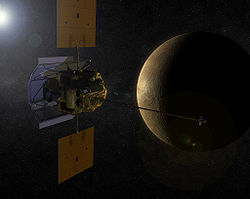- Robotic spacecraft
-
 An artist's interpretation of the MESSENGER spacecraft at Mercury
An artist's interpretation of the MESSENGER spacecraft at Mercury
A robotic spacecraft is a spacecraft with no humans on board, that is usually under telerobotic control. A robotic spacecraft designed to make scientific research measurements is often called a space probe. Many space missions are more suited to telerobotic rather than crewed operation, due to lower cost and lower risk factors. In addition, some planetary destinations such as Venus or the vicinity of Jupiter are too hostile for human survival, given current technology. Outer planets such as Saturn, Uranus, and Neptune are too distant to reach with current crewed spaceflight technology, so telerobotic probes are the only way to explore them.
Many artificial satellites are robotic spacecraft, as are many landers and rovers.
Contents
History
The first space mission, Sputnik 1, was an artificial satellite put into Earth orbit by the USSR on 4 October 1957. On 3 November 1957, the USSR orbited Sputnik 2, the first to carry a living animal into space – a dog.[citation needed]
Only seven other countries have successfully launched orbital missions using their own vehicles: USA (1958), France (1965), Japan (1970), China (1970), the United Kingdom (1971), India (1981), Israel (1988).
Design
In spacecraft design, the United States Air Force considers a vehicle to consist of the mission payload and the bus (or platform). The bus provides physical structure, thermal control, electrical power, attitude control and telemetry, tracking and commanding.[1]
JPL divides the "flight system" of a spacecraft into subsystems.[2] These include:
Structure
This is the physical backbone structure. It:
- provides overall mechanical integrity of the spacecraft
- ensures spacecraft components are supported and can withstand launch loads
Data handling
This is sometimes referred to as the command and data subsystem. It is often responsible for:
- command sequence storage
- maintaining the spacecraft clock
- collecting and reporting spacecraft telemetry data (e.g. spacecraft health)
- collecting and reporting mission data (e.g. photographic images)
Attitude and articulation control
See also: Attitude control systemThis system is responsible for the spacecraft's orientation in space (attitude) and the positioning of movable parts (articulation). Attitude and articulation are controlled in order to:
- point an antenna at Earth for communications
- point onboard instruments for collection of data (possibly in some other direction)
- adjust for the heating effects of sunlight
- provide guidance during propulsive maneuvers
Telecommunications
Components in the telecommunications subsystem include radio antennas, transmitters and receivers. These may be used to communicate with ground stations on Earth, or with other spacecraft.[citation needed]
Electrical power
The supply of electric power on spacecraft come from photovoltaic (solar) cells or from a radioisotope thermoelectric generator. Other components of the subsystem include batteries for storing power and distribution circuitry that connects components to the power sources.[citation needed]
Temperature control and protection from the environment
Main article: Spacecraft thermal controlSpacecraft are often protected from temperature fluctuations with insulation. Some spacecraft use mirrors and sunshades for additional protection from solar heating. They also often need shielding from micrometeoroids and orbital debris.[citation needed]
Propulsion
Main article: Spacecraft propulsionMechanical devices
Mechanical components often need to be moved for deployment after launch or prior to landing. In addition to the use of motors, many one-time movements are controlled by pyrotechnic devices.[citation needed]
Control
Robotic spacecraft use telemetry to radio back to Earth acquired data and vehicle status information. Although generally referred to as "remotely-controlled" or "telerobotic", the earliest orbital spacecraft – such as Sputnik 1 and Explorer 1 – did not receive control signals from Earth. Soon after these first spacecraft, command systems were developed to allow remote control from the ground. Increased autonomy is important for distant probes where the light travel time prevents rapid decision and control from Earth. Newer probes such as Cassini–Huygens and the Mars Exploration Rovers are highly autonomous and use on-board computers to operate independently for extended periods of time.[citation needed]
Space probes
Main article: Space probeA space probe is a scientific space exploration mission in which a spacecraft leaves Earth and explores space. It may approach the Moon, enter interplanetary, flyby or orbit other bodies, or approach interstellar space.
Robotic spacecraft service vehicles
- MDA Space Infrastructure Servicing vehicle — an in-space refueling depot and service spacecraft for communication satellites in geosynchronous orbit. Launch planned for 2015.[3]
- Mission Extension Vehicle is an alternative approach that does not utilize in-space RCS fuel transfer. Rather, it would connect to the target satellite in the same way as MDA SIS, and then use "its own thrusters to supply attitude control for the target."[4]
See also
- Unmanned resupply spacecraft
- Geosynchronous satellite
- Human versus robotic spaceflight
- Manned space mission
- Satellite
- Space exploration
- Timeline of Solar System exploration
- Space observatory
References
- ^ "Air University Space Primer, Chapter 10 – Spacecraft Design, Structure And Operation". USAF. http://space.au.af.mil/primer/spacecraft_design_structure_ops.pdf.
- ^ "Chapter 11. Typical Onboard Systems". JPL. http://www2.jpl.nasa.gov/basics/bsf11-1.html.
- ^ "Intelsat Picks MacDonald, Dettwiler and Associates Ltd. for Satellite Servicing". press release. CNW Group. http://www.canadanewswire.ca/en/releases/archive/March2011/15/c2866.html. Retrieved 2011-03-15. "MDA plans to launch its Space Infrastructure Servicing ("SIS") vehicle into near geosynchronous orbit, where it will service commercial and government satellites in need of additional fuel, re-positioning or other maintenance. ... MDA and Intelsat will work together to finalize specifications and other requirements over the next six months before both parties authorize the build phase of the program. The first refueling mission is to be available 3.5 years following the commencement of the build phase."
- ^ Morring, Frank, Jr. (2011-03-22). "An End To Space Trash?". Aviation Week. http://www.aviationweek.com/aw/generic/story.jsp?id=news/awst/2011/03/21/AW_03_21_2011_p23-297586.xml&headline=An%20End%20to%20Space%20Trash?&channel=awst. Retrieved 2011-03-21. "ViviSat, a new 50-50 joint venture of U.S. Space and ATK, is marketing a satellite-refueling spacecraft that connects to a target spacecraft using the same probe-in-the-kick-motor approach as MDA, but does not transfer its fuel. Instead, the vehicle becomes a new fuel tank, using its own thrusters to supply attitude control for the target. ... [the ViviSat] concept is not as far along as MDA."
Spaceflight General 
Applications Earth observation satellites (Spy satellites · Weather satellites) · Private spaceflight · Satellite navigation · Space archaeology · Space architecture · Space colonization · Space exploration · Space medicine · Space tourismHuman spaceflight GeneralHazardsMajor projectsApollo · Constellation · Gemini · International Space Station · Mercury · Mir · Shenzhou · Soyuz · Space Shuttle · Voskhod · VostokSpacecraft Destinations Space launch Space agencies Spaceflight lists and timelines General - All spaceflights
- Rocket and missile technology
- Space exploration
- milestones 1957–1969
Human spaceflight General- Manned spacecraft
- (timeline)
- Spaceflights
- 1961–1970
- 1971–1980
- 1981–1990
- 1991–2000
- 2001–2010
- 2011–present
- by program
- Soviet
- Russian
- Mercury
- Gemini
- Apollo
- Shenzhou
- Expeditions
- Spaceflights (manned
- unmanned)
- Spacewalks
- Visitors
- Expeditions
- Spaceflights (manned
- unmanned)
- Spacewalks
- Visitors
- Astronauts (Apollo
- by name
- by year of selection)
- Cosmonauts
- Married couples among space travelers
- Space travelers by name
- Space travelers by nationality
- (timeline)
- Spacewalks and moonwalks (1965–1999
- 2000–present)
- Cumulative spacewalk records
- Spacewalkers
Solar System exploration Earth-orbiting satellites - Climate research
- Communications satellite firsts
- CubeSats
- Earth observation satellites
- (timeline)
- Geosynchronous orbit
- GOES
- Kosmos
- Magnetospheric
- NRO
- TDRS
- USA
Vehicles - Orbital launch systems
- comparison of small lift launch systems
- comparison of medium lift launch systems
- comparison of orbital launch systems
- Sounding rockets
- Spacecraft (unmanned
- manned)
- Upper stages
Launches by rocket type - Ariane
- Atlas
- Black Brant
- Long March
- Proton
- R-7
- Thor and Delta
- Titan
- V-2 tests
Agencies, companies
and facilitiesOther mission lists
and timelinesMobile robots Ground OtherUnderwater Unmanned underwater vehicle (UUV) · Autonomous underwater vehicle (AUV) · Intervention AUV (I-AUV) · Remotely operated underwater vehicle (ROUV) · Underwater gliderSurface Aerial Space Unmanned space vehicle · Robotic spacecraft (list) · Robotic telescope · Space probe · Unmanned resupply spacecraft (list)Other Domestic · Military · Rescue · Medical · Disability · Agricultural · BEAM robotics · Microbotics · NanoroboticsSee also: Unmanned vehicle · Robotics · Robot locomotion · Autonomous robot · Autonomous logistics · Radio-controlled model · Remote control vehicle · Remote-controlled animal · Categories: Radio control · Unmanned vehiclesRobotics (outline) Main articles Outline of robotics · Glossary of robotics · Index of robotics articles · History of robots · Robotics worldwide · Robot Hall of Fame · Roboethics · Robotic laws · Human-robot interaction · AI Competitions · Future of roboticsRobots Humanoids · Androids · Biomorphic · Hexapods · Industrial · Articulated · Domestic · Entertainment · Military · Medical · Service · Disability · Agricultural · Food service · BEAM robotics · Microbotics · Nanorobotics • List of robots · Fictional robotsRobot classification Robot locomotion Wheels · Tracks · Walking · Running · Swimming · Climbing · Hopping · Metachronal motion · Crawling · BrachiatingRobot navigation Robot research Roboticist · Areas · Evolutionary · Kits · Simulator · Suite · Open-source · Software · Adaptable · Developmental · Paradigms · UbiquitousExternal links
Categories:- Spacecraft
- Embedded systems
- Unmanned spacecraft
Wikimedia Foundation. 2010.
